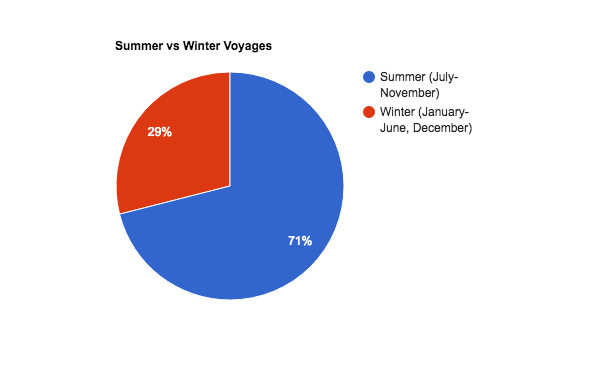New figures reveal busy shipping season on Northern Sea Route

New information revealed at the 2017 Arctic Shipping Forum held last week in Helsinki, Finland, highlights a plethora of activities on the Northern Sea Route during the year 2016. Nearly 300 different vessels conducted more than 1,700 voyages into and out of the NSR.
The new figures were part of a detailed analysis presented by Sergey Balmasov, Head of the Center for High North Logistics’ Information Office in Murmansk. According to Balmasov, the analysis shows a “continuous growth of shipments on the NSR.”
Out of the 718 vessels which were granted permits to operate on the route during 2016, 297 vessels actually traveled the route. Their cargo included “the delivery of building materials and equipment to the Sabetta port construction, the export of natural resources from current Arctic projects, and cabotage within the NSR waters,” Balmasov explained.


While vessels flying the flag of 25 different countries operated on the NSR in 2016, nearly two thirds of the ships were Russian. This continues the trend from previous years, which also saw a strong preponderance of Russian vessels. Out of 297 ships, 190 flew the flag of Russia. The secondmost frequent flag was Luxembourg with fifteen vessels, followed by Liberia with nine and Curacao with six.
The majority of ships operating on the NSR were of small or small-medium size. In contrast to for example the Suez Canal or the Strait of Malacca, which see major ocean-going vessels with 200,000 gross register tonnage (GRT) or more, ships traveling through Russian Arctic waters did not exceed 50,000 GRT. In fact, Balmasov pointed out in his presentation that nearly half the vessels were smaller than 5,000 GRT and a full two-thirds were smaller than 10,000 GRT.

Despite near record-breaking sea ice melt along the NSR during last year’s summer season, the waters remain challenging. Only 50 vessels ventured onto the route without ice classification offering protection against sea ice. Nearly 60 percent of the ships had an ice class of Arc 5 or higher.
The difficulty of navigating the route, especially during the winter months, is also reflected in the distribution of shipping activity by month.
Activity peaked in September 2016, when 345 voyages occurred on the route, followed by August and October with 264 and 263 voyages, respectively. The summer shipping season began in July, when 220 voyages were completed, and ended during November, when the route saw 116 trips.

There continues to be a marked difference between the summer and winter months, with more than 70 percent of voyages occurring during the five months from July-November. The winter season from January through June as well as December saw only 494 voyages, equal to 29 percent.

Transit shipping continues to represent only a very small share of traffic on the NSR. In 2016, the route saw 19 transit voyages, equal to just one percent of all voyages. Traffic is dominated by voyages leaving the Russian Arctic to transport raw materials, such as natural gas and crude oil, and other goods to markets. Nearly 700 voyages, equal to 42 percent of the total, fell into this category.

Transit traffic only represents a very small share of overall voyages. (Malte Humpert / HIgh North News)
The other major type of traffic on the NSR with 35 percent are voyages that depart Russian ports in Europe, primarily Murmansk and Arkhangelsk, to deliver materials and building supplies to ports along the NSR. The main receiving ports along the NSR were Sabetta, where the Yamal LNG project is located, Mys Kamennyy and Dudinka. Together they account for nearly two-thirds of all traffic destined for ports along the NSR.

While Balmasov did not speak of the overall volume of cargo transported on the route in 2016, Russian Deputy Prime Minister Dmitry Rogozin last month stated that the route will handle up to 40 million tons by 2022. According to Rogozin, this will be ten times more than in 2014 and the majority of the increase will be due to the continued exploitation and export of natural resources from the Russian part of the Arctic.